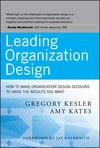
Leading Organization Design: How to Make Organization Design Decisions to Drive the Results You Want
| List Price: | US $49.95 |
| Government Price: | US $33.28 |
LEADERSHIP ALERT
TO MAKE YOUR ORGANIZATION AGILE AND COMPETITIVE, LEARN TO MANAGE COMPLEXITY – WITH A GOOD MEASURE OF CONFLICT
Conventional Wisdom Says, Avoid Complexity and Conflict – But Organization Design Experts Recommend Overlaps, Tensions and Fights That Spark Growth
NEW YORK CITY, December 8, 2010 – For years, leaders have tried to create smooth-running organizations where complexity, tension, conflict and overlapping lines of authority are at a minimum.
But that may not be the right approach for a new era of global competition, say two experts on organization design. Leaders should instead create organizations that are deliberately complex and generate tension and conflict. The result will be agility and the ability to take advantage of fast-moving global opportunities.
“Organizations should embrace, not avoid complexity,” says Amy Kates, managing partner at KatesKesler Organization Consulting and coauthor of the forthcoming Leading Organization Design: How to Make Organization Design Decisions to Drive the Results You Need (Jossey-Bass, December 2010). The book describes the often-overlooked discipline of organization design – the deliberate configuration of business units, systems, support functions, geographic offices, reporting lines and responsibilities.
Organization design is critical but many leaders ignore it. They concentrate instead on vision, strategy and brand messaging but fail to establish an organization to execute them, Ms. Kates says. “Or they focus excessively on creating smooth, tension-free organizations.”
“A simple organizational structure can be a good thing, but there are also benefits to complexity and conflict, and to avoid them often means leaving value on the table. It usually means losing creative tension and the ability to make fast decisions close to the marketplace. Effective enterprise leaders design the organization for complexity, and then they govern it in a hands-on way,” says coauthor and KatesKesler managing partner Gregory Kesler.
In an interview or bylined article, Ms. Kates and Mr. Kesler can discuss:
- How to tell the difference between good and bad tension. “Tension is bad if it’s created by conflicting objectives,” Ms. Kates says. “Good tension is tension between two vantage points that by nature are somewhat in conflict, but only when they battle it out and find higher ground is value fully extracted from an asset. I want the brand manager and the country manager to work through the conflicts; I don’t want a compromise, I want a point of higher ground that allows us to get the most out of our assets. Executives who can generate and manage that tension will create the most value for shareholders.”
- Why yesterday’s organization models often fail in today’s markets. “The old idea of product divisions often isn’t effective today,” Mr. Kesler says. “Executives like this model because it is simple to grant authority and accountability to one general manager. These units are very controllable. But while they are simple on the inside, they are often complex and challenging for customers who buy from across multiple units. Divisions also make it difficult to innovate and achieve scale when working across units – something today’s markets require. The feeling of ownership that division general managers have becomes a liability. It creates rigidity and often slows innovation that requires managers to partner inside and outside the organization.”
- Why centralization is good – but only up to a point. “Increasing centralization is inevitable as companies become more global and as they look for more leverage, but it can be carried too far,” Ms. Kates says. “Many leaders think that by centralizing they can bring bigger new product ideas to the market much faster and at the same time reduce cost, and there is some truth to this. But in most industries bringing new products into emerging markets is not a matter of transferring products from Europe or North America into India or China. It is a much more nuanced problem, and nuances in structure are necessary.”
Adds Mr. Kesler, “It’s critical that organizations have some capability to develop products for local markets. Companies are learning to manage two different product platforms by geography, with one organization focused on developing markets and another focused on developed markets.”
To arrange a conversation with Amy Kates and/or Gregory Kesler, please contact Frank Lentini at Sommerfield Communications, Inc. at (212) 255-8386 / [email protected].





